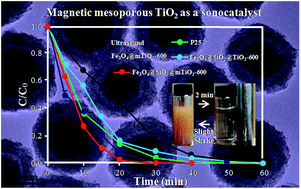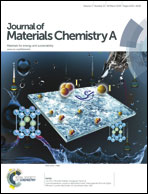Uniform core–shell structured magnetic mesoporous TiO2 nanospheres as a highly efficient and stable sonocatalyst for the degradation of bisphenol-A†
Abstract
Uniform core–shell structured magnetic mesoporous TiO2 (Fe3O4@SiO2@mTiO2) nanospheres were fabricated via a kinetically controlled Stöber method. A silica interlayer with a thickness of ∼25 nm was introduced as a passivation barrier to prevent photodissociation, as well as increase the thermal stability of the core–shell materials. After crystallizing at 600 °C under nitrogen, the resultant nanospheres (Fe3O4@SiO2@mTiO2-600) possessed well-defined core–shell structures with a high magnetic susceptibility (∼17.0 emu g−1) and exhibited uniform mesopores (∼5.2 nm), large BET surface area (∼216 m2 g−1) and large pore volume (∼0.20 cm3 g−1). More importantly, the magnetic mesoporous TiO2 was demonstrated for the first time as a highly efficient and stable sonocatalyst for the degradation of bisphenol-A. The pseudo first-order-reaction constant of the magnetic mesoporous TiO2 was measured to be 0.164 min−1, which is 1.49 and 2.27 times higher than that of P25 and ultrasound alone, respectively. The remarkable performance is attributed to the fast mass diffusion, large adsorption rate and enhanced hydroxyl-radical-production rate of the nanospheres. More importantly, the catalyst can be easily recycled within 2 minutes using an external magnetic field, and a constant catalytic activity is retained even after eight cycles. This study paves a promising way for the design and synthesis of magnetically separable sonocatalysts for the degradation of organic pollutants, which is of significant importance for practical applications from both environmental and industrial points of view.


 Please wait while we load your content...
Please wait while we load your content...